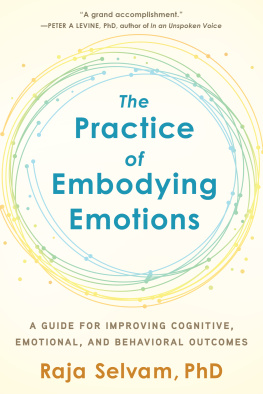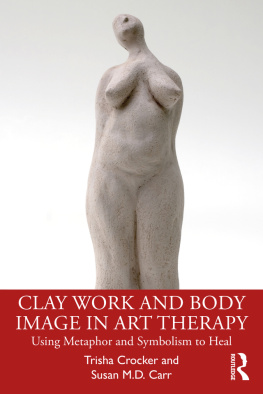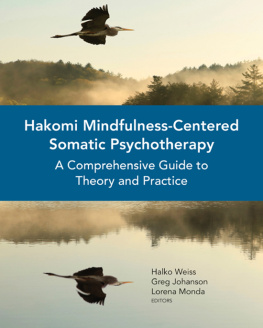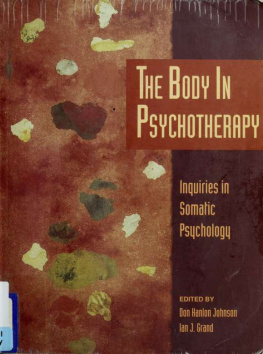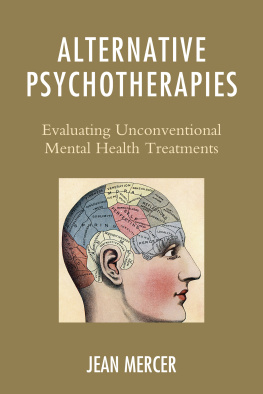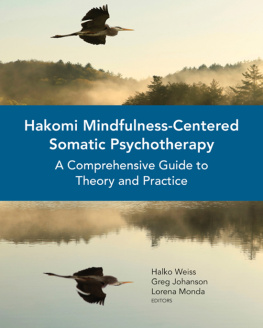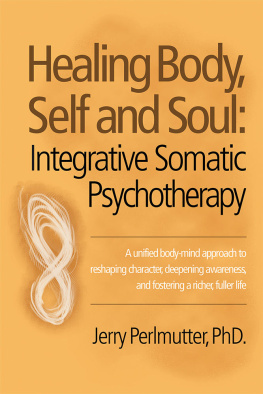Body-Centered
Psychotherapy: A Toolkit
Methods for using the body for emotional healing
Jean M. Clinton
Copyright 2005
Jean M. Clinton
All rights reserved.
ISBN: 1493724908
ISBN-13: 978-1493724901
DEDICATION
To the true teachers of emotional healing..
Those who struggle with mental health issues on a daily basis .
CONTENTS
Introduction |
| History of the Body-Mind Relationship |
| Misguided Body-C entered Psychotherapy |
| Traditional Body-C entered Psychotherapy Methods |
| Scientific Support for Body-C entered Psychotherapy |
| Non-T raditional Body-Centered Psychotherapy Methods |
| Issues for the Future of Body-Centered Psychotherapy |
| Conclusion |
Appendix A: Nutritional Therapy in the Treatment of Alcoholism |
Introduction
The success of traditional counseling depends heavily on clients abilities to verbally articulate thoughts and feelings that are in their conscious awareness. Additionally, the effectiveness of verbal therapies hinges, to a large extent, on the therapists ability to view the world from the clients subjective perspective. Thus, most psychotherapeutic approaches used today require cognitive and communication capabilities on the part of both the client and the therapist. Because of this, verbal therapies provide only a narrow window into the clients phenomenological world. As communication researchers claim, most interaction between humans is nonverbal. As such, using words to express emotions is frequently an inadequate exchange of information. This limited glimpse into the clients conscious mind often necessitates long-term therapy to produce emotional health. In some cases, clients endure months of therapy without any gain. It is time to expand traditional therapy practices to include, not just the mind, but the body as well. A holistic body-mind approach provides the most expeditious means for accessing and treating psychological material, both conscious and unconscious. By viewing the body as a conduit to the mind, the body can be used as both a diagnostic and treatment tool. Thus, achieving a body-balanced brain is the most effective means for helping clients resolve emotional issues.
Ancient healers from a variety of Eastern traditions long ago adhered to a whole-person philosophy as they viewed the body and mind as inseparable. However, in the 17th century, this body-mind unity was severed as scientists and religious leaders waged a battle over the jurisdiction of the body and the mind. This philosophical tug-of-war ended with the Church claiming the mind and soul and the medical community owning the body. This dualistic perspective continued until the early 1900s when a few radical thinkers initiated a re-union of the body and mind, claiming an integration of the two was necessary for mental health. Because of the revolutionary work of some of these progressive theorists, psychotherapeutic modalities such as somatic psychology, Gestalt therapy, psychodrama, and some behavioral techniques, make full use of the body as a healing conduit to the mind. Since the introduction of these body-centered approaches, scientific knowledge about the interconnectedness of the body and mental health has exploded, providing irrefutable evidence that the body and mind are one. Non-traditional body-centered psychotherapeutic techniques; such as Reiki, Therapeutic Touch, Behavioral Kinesiology, Rolfing, Feldenkrais Method, Rubenfeld Synergy, and Cranio-sacral Therapy; show great promise for resolving deep-seated emotional issues. Skeptics exist, clinical issues remain, and efficacy studies are lacking. However, these are obstacles that all new paradigms face and are frequently overcome with time. Evidence for body-centered psychotherapy is rapidly mounting as this holistic approach to counseling is emerging as the way of the future.
1 History of the Body-Mind Relationship
The idea that the body is integrated with mental health is thousands of years old. Since 3000 BC, the traditional health systems of ancient Eastern cultures have long recognized the connection between the body and emotions. In the fifth century BC, Hippocrates advanced the body-mind perspective by defining the medical system of the four humors where different body fluids were believed to affect behavior. His theory emphasized the behavior-physiology interface in a novel way when he postulated that four types of temperaments corresponded to certain body fluids. Hippocrates believed that emotional problems resulted when body fluids were excessive or out of balance (Corsini, 2001; Rolfe, 2002). For thousands of years, this holistic body-mind philosophy was the predominant view for understanding emotional health. However, in the 17th century, this body-mind unity was severed.
During the 1640s, a rift occurred between science and religion where both sides played a role in fragmenting the mind and body. The idea that the mind and body were two completely separate entities was advanced by Rene Descartes, a prominent French scientist, mathematician, and philosopher. Descartes was deeply involved in exploring human anatomy and physiology through research which involved dissecting human cadavers. In order to get the bodies he needed for his investigations, Descartes negotiated a deal with the religious leaders of the Church. Descartes agreed that he would leave the mind under the purview of the Church if he and the medical community could claim the physical realm as their own. Descartes convinced religious leaders that the mind and the body were two different entities and he maintained that each could exist without the other. This bargain set the stage for dividing the human experience into two distinct and separate spheres. The result of this deal was Cartesian dualism, the Western school of thought that the body belonged to medicine and the mind, emotions, and consciousness were in a separate domain altogether. Descartes dualistic mind and body philosophy was widely accepted by the intellectual culture of his time and his convictions shaped psychology and medicine for centuries to come (Kirk, 2003).
Descartes separation of the mind and body encouraged a description of physical diseases that did not involve the mind and a system of emotional illness that eliminated the body. Mind-body dualism continued to evolve and was perpetuated by the renowned scientist Isaac Newton in the late 1600s. Newtons linear, reductionist model of science advocated that the organism being studied be reduced to its smallest unit. Following this reductionist philosophy, Morgani, a mid-18 th century physician, suggested that a patients symptoms could be traced to physical malfunctions in specific organs. Forty years later, Bichat demonstrated that it was diseased tissues, not organs that caused ailments. By 1850, Virchow showed that it was, in fact, specific cells within the tissue of organs that caused disease. Thus, the view that a patients symptoms could be reduced to a cellular malfunction became the prevalent view of the day. This reductionist model further disassociated the body from the mind and emotions (Byers, 1988).
For many years, the dualistic view that the body and mind were separate domains was followed without question. However, in 1884, a significant challenge to this Cartesian philosophy was launched by William James (as cited by Herring & Roberts, 2002) with the publication of his article What is an Emotion? James, a psychologist and philosopher, re-introduced the long forgotten notion that the body and mind were interconnected. His theory was based on his observations that emotions were consistently accompanied by various bodily phenomena such as increased pulse, sweaty hands, and tense muscles. According to James, these physiological processes occurred first and a corresponding emotion arose after the brain became aware of the bodily changes. James teachings and writings made it more apparent that the Cartesian way of thinking did not adequately describe medical and psychiatric health. Separating the material world of the body from the nonmaterial reality of emotions no longer was a viable approach.
Next page



